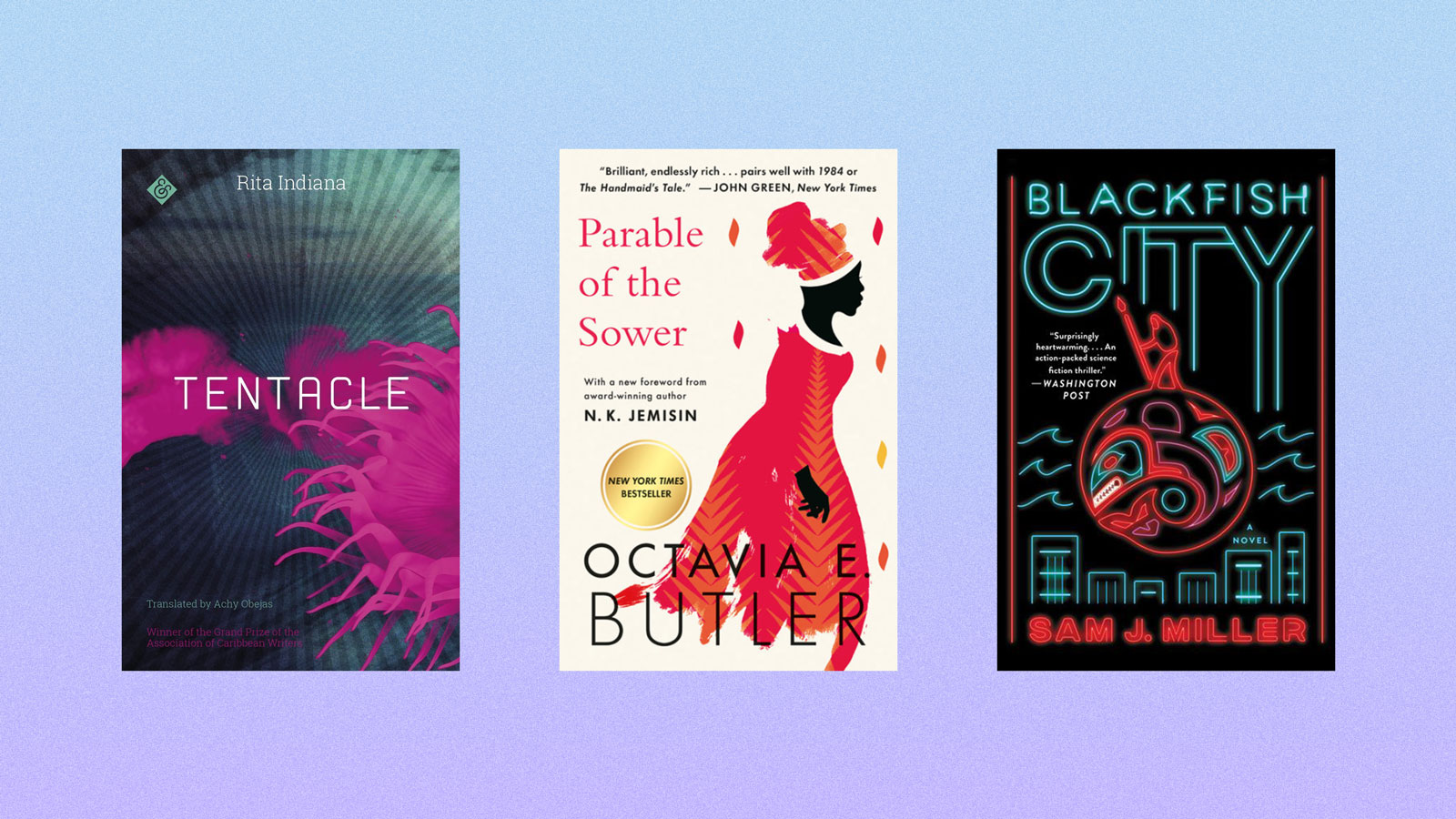This story is part of Fix’s Climate Fiction Issue, which explores how fiction can create a better reality. Check out the full issue here, including the short stories in Fix’s first-ever climate-fiction contest, Imagine 2200.
***
At its best, fiction inspires people and makes them think. Sometimes it even spurs them to action. Speculative novels and short stories in particular are in a unique position to spark change with their visions of what the future could be.
This is especially true of climate fiction, which can make readers ponder the impacts of this crisis on their lives and those of future generations. The term itself is a relatively new one, but explorations of how humanity will respond to the existential crisis of a warming world date to at least the 1960s and ’70s, when J.G. Ballard and Ursula K. Le Guin wrote prescient stories about rising seas. Octavia E. Butler warned us about the societal impacts of climate change more than a decade before An Inconvenient Truth introduced the concept to mainstream audiences.
The genre has only grown more timely, and popular, as the depth of the crisis comes into focus. It also has spawned an almost dizzying array of subgenres that reflect the lived experiences — current and future — of Black, Indigenous, Latinx, and other folks, and a galaxy of deeply intersectional worlds in which all communities see themselves represented in the future of our planet, one often grounded in justice and abundance.
That vision is a hallmark of solarpunk and hopepunk, two genres that embrace optimism and celebrate a clean, green, just society. They aren’t necessarily utopian — even the most idealistic authors grapple with the complicated and often messy realities of life — but they provide a glimmer of hope that, together, we will see a way through the damage already done and the dilemmas yet to come.
We can all use a measure of that right now, so if you’re new to climate fiction, here’s a reading list to explore where it started and where it’s headed. And if you’re already well-versed in this genre, there may be a few gems here you haven’t yet read.
***
The Drowned World, by J.G. Ballard (1962): Ballard’s pioneering work of climate fiction, set in 2045 in a world left flooded and largely uninhabitable by global warming, is not as far-fetched as it surely seemed when it was published nearly six decades ago.
The New Atlantis, by Ursula K. Le Guin (1975): You can’t go wrong with anything by Le Guin, but this novella is a remarkably prescient prediction of the climactic and geological upheaval wrought by a warming world.
Parable of the Sower, by Octavia E. Butler (1993): This seminal cli-fi novel addresses climate change, social injustice, and corporate greed in a world that has, in the years since its publication, moved beyond fiction to reality.
Zahrah and the Windseeker, by Nnedi Okorafor (2005): Okorafor combines West African mythology with a fantastical world of plant-based technology to tell the story of a 13-year-old girl who embarks on a dangerous quest to save a friend’s life.
Stochasticity, by Tobias S. Buckell (2008): In a dystopian post-oil Detroit, a man gets tangled up with some ecoterrorists who have a creative and fast-moving plan. It’s a fun adventure that takes an unexpectedly hopeful turn. (Editor’s note: Buckell was a story reviewer for our Imagine 2200 climate-fiction contest.)
The Swan Book, by Alexis Wright (2013): Aboriginal myths, legends, and reality intertwine in this wildly imaginative story set in Australia, which has been devastated by climate change and war. It’s a challenging read, but those who stick with it will be rewarded.
The Water Knife, by Paolo Bacigalupi (2015): A militarized fight over water rights in the Southwest is sparked as the Colorado River dries up. A dark thriller, the novel deftly explores corporate greed, social inequality, deregulation, and privatization.
The Fifth Season, by N.K. Jemison (2015): Although set on a distant world torn asunder by cataclysm, the first book in the Broken Earth trilogy addresses racial and social oppression with obvious parallels to the injustices of this world.
Everything Change: An Anthology of Climate Fiction, Vol. 1 (2016), Vol. 2 (2018), and Vol. 3 (2021), various authors: These anthologies, published by the Arizona State University Imagination and Climate Future Initiative, compile the best entries in the program’s annual climate-fiction contest. The stories, which can be downloaded for free, explore how our responses to this crisis will shape the world we inhabit.
American War, by Omar El Akkad (2017): El Akkad drew on his experiences as a war correspondent to write a harrowing future history of a second U.S. civil war that begins when northern states outlaw fossil fuels in 2074.
Tentacle, by Rita Indiana (2018): This sinister novel, set in the Caribbean during a time of environmental collapse sparked by three ecological disasters, reflects on the region’s colonial history as it portrays an era of capitalism run amok. It was originally published in Spanish under the title La mucama de Omicunlé.
Blackfish City, by Sam J Miller (2018): Disease ravages a floating Arctic city of climate refugees beset by corruption and widening social inequality when a mysterious warrior, accompanied by her orca and polar bear, arrives. It sounds dystopian, but it’s an optimistic story about human connection.
The Overstory, by Richard Powers (2018): This exquisitely researched Pulitzer Prize–winning novel follows the lives of five trees and nine people across generations to show how deforestation and disregard for the complexity of nature led to the existential crisis we now face.
Trail of Lightning, by Rebecca Roanhorse (2018): Dinétah (formerly Navajo Nation) emerges as an independent state in a world decimated by environmental disaster. The gods and heroes of Indigenous legend roam this desolate world, and it falls to a supernaturally gifted monster-killer and a medicine man to unravel a mystery that threatens the future.
Implanted, by Lauren C. Teffeau (2018): Extreme weather has forced humans into domed cities. As they approach the day they will emerge, a young woman uncovers a nefarious plot that could change everything. Implanted is a thought-provoking look into our environmental responsibilities and the dangers of a hyperconnected society.
“Under the Grid,” by Andrew Dana Hudson, published in The Weight of Light: A Collection of Solar Futures (Arizona State University; 2019): This optimistic short story, which you can read for free at Grist, imagines the city of Detroit as domed by a massive solar-powered grid and what life might be like under it. (Editor’s note: Hudson was a story reviewer for our Imagine 2200 climate fiction contest.)
War Girls, by Tochi Onyebuchi (2019): Two sisters separated by civil war face overwhelming odds as they attempt to reunite in a country barely surviving a global climate apocalypse. This captivating story combines an epic adventure with the history of Nigeria and an exploration of what it means to be human.
McSweeney’s Issue 58: 2040 A.D., various authors (2019): The celebrated literary journal worked with the National Resources Defense Council on this collection of 10 stories, by writers including Tommy Orange and Luis Alberto Urrea, that imagine what the world will look like if it actually achieves the outcomes outlined in the IPCC’s 2019 report on the impacts of global warming of 1.5 degrees Celsius.
The Ministry for the Future, by Kim Stanley Robinson (2020): Robinson is among the best-known climate-fiction writers around, and the opening chapter of this riveting novel is among the most harrowing examples of climate fiction yet written. The story, which uses fictional eyewitness accounts to reveal the looming impacts of climate change and how we might overcome them, only gets better from there.
Multispecies Cities: Solarpunk Urban Futures, edited by Sarena Ulibarri and others (2021): This anthology of short fiction imagines what future cities could look like if we strive for ecological and multispecies justice. Humans learn to communicate with dolphins and trees, work alongside whales and eels, and more. (Editor’s note: Ulibarri was a story reviewer for our Imagine 2200 climate fiction contest.)
Explore more from Fix’s Climate Fiction Issue:
- How a fictional forestlike burial ground could replace traditional cemeteries
- A glossary of need-to-know climate-fiction terms and genres
- Read the 12 winning stories of Fix’s climate-fiction contest






